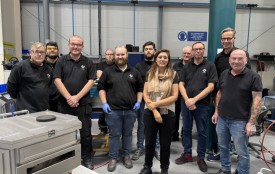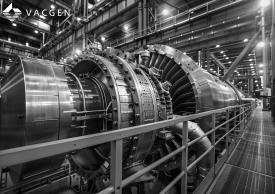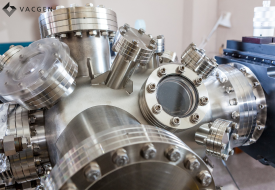When it comes to talking about vacuum solutions and their various applications, there is a lot of technical terms to understand. We have therefore created this glossary of key terms and descriptions to help ease your understanding of the terminology used in our industry.
Atomic Layer Deposition (ALD) – A semiconductor manufacturing technique used to deposit thin films of material onto a substrate. ALD is performed in a vacuum chamber, using precursors that are vaporized and then condensed on the substrate. ALD is used in the production of semiconductor devices, as well as in other applications such as optoelectronics, solar energy, and batteries.
Build-to-print – A build-to-print process sees a product manufactured according to a customer’s own drawings or specifications. This is not to be confused with Copy Exactly! which is explained in this glossary.
Chemical vapour deposition (CVD) - A process used to deposit thin films of semiconductor materials onto a substrate. CVD is used in the semiconductor industry to fabricate integrated circuits and other microelectronic devices. It is also used to deposited optical coatings, diamond-like carbon coatings, and protective coatings for semiconductor substrates. CVD is conducted in high vacuum chambers.
Cleanroom ready – A cleanroom has filtered air to provide a clean environment where products or components are assembled or processed; products build in a clean room are said to be clean room ready. To be "cleanroom ready," a product or component must meet certain specifications for cleanliness, particle size, and contaminants. A cleanroom ready semiconductor vacuum chamber is a specialized piece of equipment that helps to create an ultra-clean environment for semiconductor manufacturing. The chamber is designed to meet the cleanliness requirements of the semiconductor industry.
Conflate Flanges – A Conflat flange is manufactured from stainless steel. They have equally spaced bolt holes around the circumference used to tighten and make the seal. A Conflat flange has a tough machined knife edge which will cut into a copper gasket to make in the seal as 2 Conflat flanges are compressed.
Copy Exactly! – A factory strategy model developed for the semiconductor industry in the 1980s to ramp up production of semiconductor microchips. Now widely used throughout the electronics industry due to the benefits of replication it brings to manufacturers and customers.
Electron-beam - Also known as e-beam, is a stream of high-energy electrons that is used for surface analysis, semiconductor patterning or within PVD sources.
Electropolish - A electrochemical process that removes material from a conductor to produce a smooth, high-quality finish. It is often used to improve the appearance of stainless steel or other metals. Electropolishing can also be used to remove impurities from the surface of the metal, which can improve its durability and performance.
Extreme high vacuum (XHV) – Where the pressure inside the chamber is measured at 10-12 mbar and lower. This is the lowest point of achievable vacuum and used for specialised applications.
Flanges - These devices are used to create a seal between two components in a vacuum chamber, creating an airtight seal that prevents air from entering or leaving the vacuum chamber. This is essential for creating the vacuum environment necessary for many scientific experiments. In addition to their sealing function, flanges also provide a way to attach other components to the vacuum chamber, such as vacuum pumps, sensors, and electrical connections. Flanges come in 2 main types Conflat Flanges (CF) or Klein Flanges (KF)
Fusion - In nuclear fusion, two atomic nuclei join to form a single, heavier nucleus. This process releases huge amounts of energy and is the basis for the sun's energy production. Fusion reactions only occur under high temperatures and high pressures, so they must take place in a high vacuum. In a laboratory, this is usually accomplished using a vacuum chamber.
High vacuum (HV) - Where the pressure inside the chamber is measured at 10-3 to 10-7mbar. High vacuum environments are necessary for a variety of applications, including those in semiconductor manufacturing, scientific research, and aerospace engineering.
Klein Flanges – Often made of aluminium are a quick flange to connect. 2 Klein fittings are connected with the use of an O-ring carrier and O-ring (often made from Viton) and a clamp to pull the seals together.
Leak test - A vacuum chamber test used to determine whether a product can hold vacuum. The principle is simple: if a product can hold vacuum, then it does not have any leaks. Everything leaks to some degree, the levels of leak rate (HV, UHV, XHV) determine the application environment. VACGEN’s own approach to leak tests sees us utilise a Helium Mass Spectrometer which can detect the presence of Helium within a vacuum environment.
Leak valves - Allow gases to flow into the vacuum chamber at a controlled rate, changing the vacuum pressure inside the chamber. Our range of UHV leak valves are used for precise control of the flow of gas into a vacuum system from an external source. The range of UHV leak valves are of all metal construction and due to their ultra-fine control actuator and low internal volume have extreme repeatability, offering excellent response over a wide dynamic pressure range.
Lithography - A process used in the semiconductor industry to transfer a circuit pattern onto a silicon wafer. It is performed in a vacuum chamber using a focused beam of ultraviolet light.
Molecular Beam Epitaxy (MBE) chamber – A deposition technique which requires a UHV environment. MBE is a process in which a thin single crystal layer is deposited on a single crystal substrate using atomic or molecular beams generated in Knudsen cells contained in an ultra-high vacuum chamber.
Non-evaporable getter (NEG) – NEG pumps devices used to remove trace gasses from a vacuum environment. They are used in semiconductor manufacturing and other ultra-high vacuum applications where it is important to have a low level of contaminants.
O-ring – A commonly used component in vacuum chambers to create a seal between two mating surfaces, such as a flange, lid or shaft. This seal helps to maintain the vacuum by preventing air from flowing into or out of the chamber. To create an effective seal, the O-ring must be properly sized and installed. O-rings can be purchased in a variety of sizes and materials, and it is important to select the correct size for your vacuum chamber or device.
Physical vapour deposition (PVD) – A process used to deposit thin films in a vacuum chamber. In PVD, the desired film material is vaporized in a vacuum environment and then deposited onto the substrate surface. PVD can be used to deposit a wide variety of materials, including metals, alloys, semiconductors, and ceramics. PVD processes are commonly used in the many industries to deposit thin films for semiconductor device fabrication; hard coatings for machine tools; coatings for glasses etc.
Research chamber - A vacuum chamber used to conduct experiments in a controlled environment. Research chambers are often designed to UHV standards and maintain a vacuum for extended periods of time. This allows for delicate or sensitive experiments to be conducted without the risk of contamination.
Residual gas analysis (RGA) - A technique used to identify and quantify aspects of a high vacuum environment. When a RGA analysis is conducted it produces a full mass spectrum of the elements present, along with their respective magnitudes.
Sample Manipulation – Movement and positioning of samples and substrates within a vacuum system. It is a key part of material analysis to identify key features or defects within a sample. VACGEN produce manipulators for this purpose.
Transfer Device – Transfer devices are deployed when moving and transferring a sample or component within a vacuum system from one device to another. These components come in various forms, including wobble sticks, distribution centres or magnetic transfer arms.
UHV Clean - UHV Clean is a term used to describe the condition of a device or chamber where all contaminants such as moisture and oils have been removed from the surfaces and prepared for UHV use.
Ultra-high vacuum (UHV) – Where the pressure inside the chamber is measured at 10-7 to 10-12 mbar. The key difference between HV and UHV is bake-out. To reach UHV pressure range, vacuum components and chambers need to be placed and ‘baked’ under vacuum condition at a temperature of >100oC. This process drives out gases and other contaminants trapped inside the chamber and components. Careful consideration needs to be made in material selection to reach UHV.
Vacuum – A state in which the density of particles is theoretically at zero. However, reaching total vacuum is not possible and only limited vacuum ranging from low to extreme high levels can be achieved. A confined environment such as this will have a lower pressure than atmospheric pressure.
Vacuum chamber - An enclosed space from which air and other gases are removed, creating a vacuum. Vacuum chambers are used for a variety of purposes, including scientific research, industrial processes, and product testing.
Vacuum system - A system designed to produce materials, or analysis of materials where vacuum is an essential requirement. A vacuum system consists of; vacuum pumps, chambers, interconnecting piping and a variety of other components. Each vacuum system is adapted to meet the application needs.
Wafer - A thin slice of semiconductor material, usually made of silicon, used in the fabrication of integrated circuits and other microelectronic devices. The wafer serves as the substrate upon which microcircuits are built.
Wobble stick – A mechanical device used to move a sample within a vacuum chamber through a chamber wall. Often used to move a small sample from a transfer probe to an XYZ manipulator or stage.








